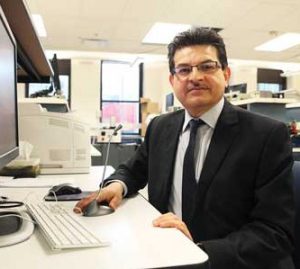
By Katherine Gombay
Speed and efficiency!
These are words more often associated with the factory floor than with a university setting. But they are at the heart of the changes Amar Sabih has brought to the Undergraduate Mechanical Engineering labs since he took over as the Academic Associate Director five years ago. He brims with energy as he displays the newly renovated space and describes how he has transformed the work being done there.
Sabih’s job is to ensure that 200 undergraduate mechanical engineers each term understand the connections between the theories they learn in textbooks and what the machines in the labs can actually do. Both for him and for the TAs who work in the labs, this work involves a certain amount of repetition. So Sabih took the innovative step of preparing videos about the lab equipment that students can download onto their cell phones and watch in preparation for the lab.
Time-consuming fun
“Why ask the TAs to repeat the same information over and over again?” asked Sabih. ”Students leave without the knowledge they require sometimes, and then they come back after a week and have forgotten everything [they’ve learned].” With students watching the videos on their cell phones, Sabih believes they arrive at the lab better prepared to do the experiments, and with a sounder knowledge of both the theories and the equipment involved.
In what he described as “time-consuming fun,” Sabih created four videos, each about 20 to 25 minutes long, explaining different aspects of mechanical engineering theory and practice. Sabih is clearly proud of the results, which have cut down on students’ time in the labs, and replaced their hands-on time with the equipment during the past year when the labs were inaccessible during renovations.
A question of respect
Sabih’s use of voice comments on the students work to give them spoken feedback is even more innovative. This project is still in its initial stages, and relies on the fact that Sabih’s students now submit their course work entirely online using McGill’s WebCT Vista system, where all the course material, including the videos, is to be found. Sabih uses one of the options on the Adobe Acrobat Professional Software (a similar function exists in all versions of Word Office Suite since 2007) to record audio comments about the students’ work.
When a student receives the marked copy of the PDF they submitted, they can then click on the microphone icon on the screen to hear their marker’s comments. In Sabih’s view, this style of marking is not only more efficient in terms of telling the student exactly where a problem lies, it also shows the students more respect. “My way of teaching is different – it is a more human interaction – they aren’t just a number on my list,” said Sabih. “I feel I know their difficulties and I try to help them through lots of communication.”
From using recorded comments to mark the students’ work, to creating course videos for students to be downloaded onto cell phones, to using the course chat room to prepare students for exams, Sabih is a crusader for educational innovation. By using the communications capacities of new technologies, he has been able to develop new, more efficient, techniques for giving information and feedback to students while building more human relationships with them at the same time.
